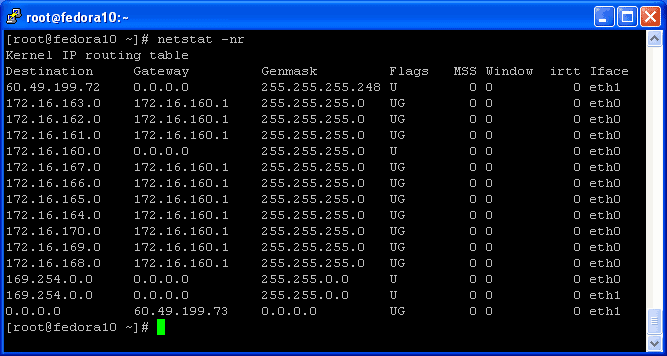Definition of Routing Table in The Network Encyclopedia.
What is a Routing Table?
A Routing Table is an internal table that a computer or router uses to determine which router interface to send packets to, based on their destination network addresses.

Microsoft Windows platforms automatically build their own routing tables, which are used to determine whether to forward specific packets to:
- The local network segment
- A near-side router interface
- The default gateway for the segment
To view the internal TCP/IP routing table on a computer running Windows 2000, Windows NT, Windows 98, or Windows 95, type route print at the command prompt.
A typical routing table looks like the following:
Active Routes:
Network Address Netmask Gateway Address Interface Metric
127.0.0.0 255.0.0.0 127.0.0.1 127.0.0.1 1
172.16.8.0 255.255.255.0 172.16.8.50 172.16.8.50 1
172.16.8.50 255.255.255.255 127.0.0.1 127.0.0.1 1
172.16.255.255 255.255.255.255 172.16.8.50 172.16.8.50 1
224.0.0.0 224.0.0.0 172.16.8.50 172.16.8.50 1
255.255.255.255 255.255.255.255 172.16.8.50 172.16.8.50 1
This computer has a single network interface card (NIC) with the address 172.16.8.50. The columns of this table are as follows:
- Network Address: A destination network address on the network
- Netmask: The portion of the network address that must match in order for that route to be used
- Gateway Address: Where the packet needs to be forwarded (a local NIC or a local router interface)
- Interface: The address of the NIC through which the packet should be sent
- Metric: The number of hops to the destination network
Forwarding table
Routing tables are generally not used directly for packet forwarding in modern router architectures; instead, they are used to generate the information for a smaller forwarding table. This forwarding table contains only the routes which are chosen by the routing algorithm as preferred routes for packet forwarding. It is often in a compressed or pre-compiled format that is optimized for hardware storage and lookup.
This router architecture separates the Control Plane function of the routing table from the Forwarding Plane function of the forwarding table. This separation of control and forwarding provides uninterrupted performance.
Static Routing
Static routing is a form of routing that occurs when a router uses a manually-configured routing entry, rather than information from a dynamic routing traffic. In many cases, static routes are manually configured by a network administrator by adding in entries into a routing table, though this may not always be the case. Unlike dynamic routing, static routes are fixed and do not change if the network is changed or reconfigured. (Read the Static Routing article)
Dynamic Routing
Dynamic Routing is a routing mechanism handled by a routing protocol, such as Routing Information Protocol (RIP) or Open Shortest Path First (OSPF) Protocol, that dynamically exchanges routing information among routers on an internetwork. Routers that use this method are called dynamic routers.
Routing table in Microsoft Exchange
In Microsoft Exchange Server, the routing table is the internal table that defines how messages can be routed to other sites in the Exchange organization and to foreign mail systems through installed connectors and gateways. This routing table is generally known as the Gateway Address Routing Table (GWART).